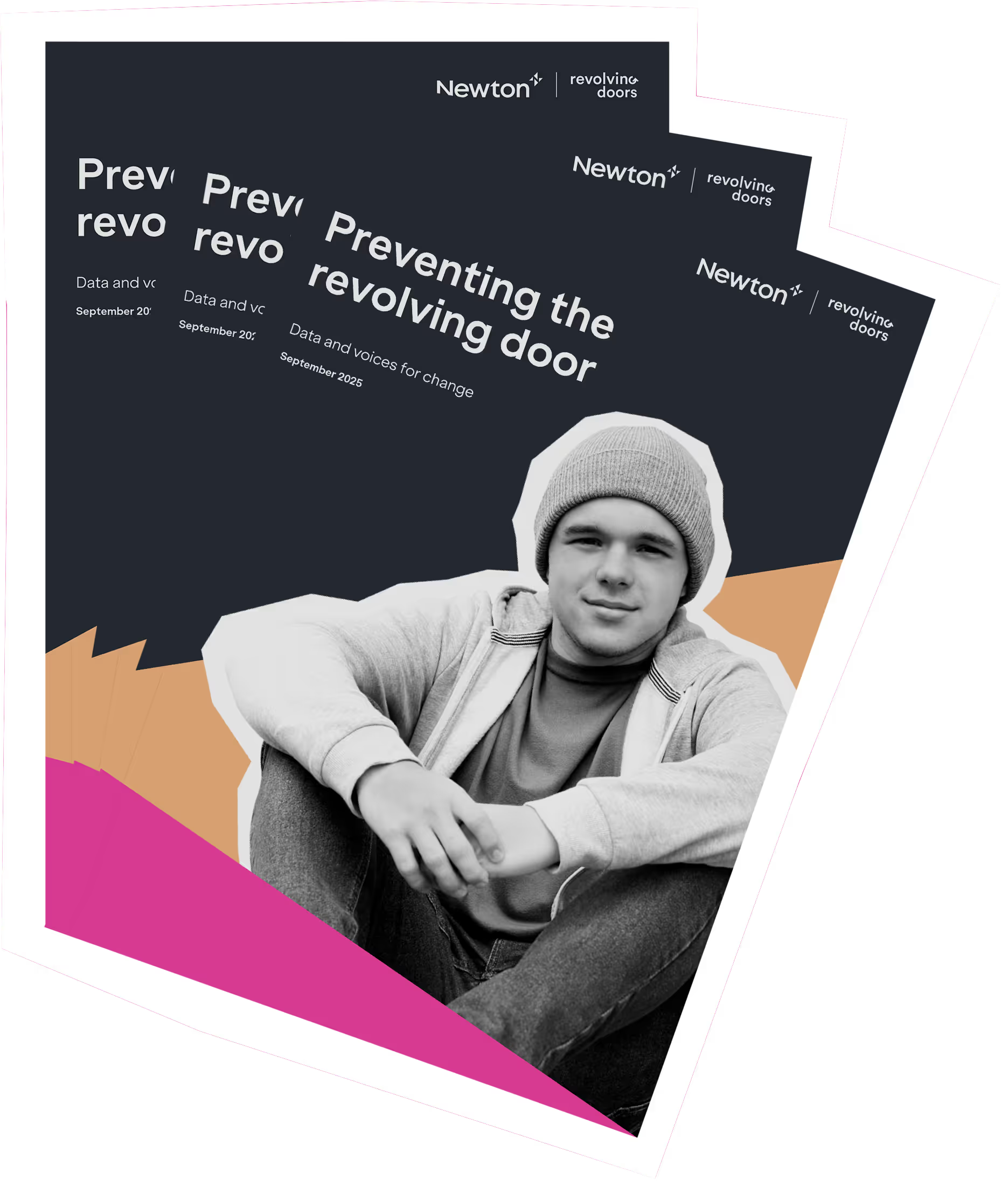Lived experience findings
Findings from 20 in-depth interviews with people who have lived through the revolving door of crisis and crime.



This section shares findings from 20 in-depth interviews with people who have lived through the revolving door of crisis and crime.
Their stories span early life through to the present day, showing how personal circumstances and interactions with public services have shaped their lives. This includes:
- how missed opportunities often escalate people further into the justice system,
- where positive interventions make a lasting difference,
- how the cycle of reoffending and harm can be broken.
While based on 20 interviews, these themes are not unique. These themes are familiar, reflecting what Revolving Doors has heard consistently over many years from people in repeat contact with the criminal justice system. By grounding solutions in lived experience, this research aims to end the status quo, break cycles of harm, and unlock better use of public money and human potential. These insights highlight a clear truth: people are not defined by their offending. With timely, coordinated and compassionate support, they can and do go on to rebuild their lives, contribute to their communities, and act as powerful voices for change.
Being part of this project felt real, hard, honest and important. Sharing our stories isn’t about us - it’s about making sure others don’t go through the same cycles we did. It’s about using what happened to us to help the system change.
We need to pay attention to the revolving door and those in it, because these are real people stuck in a cycle that damages them and everyone around them. If we don’t pay attention, nothing changes. The system will keep on failing people who need support the most.
Finally, we can see the scale of what’s happening in black and white. It’s not just numbers, it’s people’s lives, potential wasted and a system that keeps letting people down. Showing it like this makes it impossible to ignore.
However, this report doesn’t just show the problem. It points to what can be done to stop people getting stuck in the revolving door. If these recommendations are taken seriously and acted on, we can finally start building a system that supports people instead of constantly letting them down.
Investing in resources in the community and tackling issues at the roots will make us more successful at rehabilitating and reducing offending. We know from our personal experiences how meaningful support has helped us to break cycles of crisis and crime – to have the opportunity to grow, to have our voices heard and to help others on their journey away from the revolving door.
Being part of this project has reminded us why lived experience matters. It’s not just about telling your story, it’s about making sure what we’ve been through isn’t in vain. We’re giving back and we’re making change for others who are still where we once were.
Without action, the revolving door keeps on spinning. These recommendations aren’t abstract, they are ways to actually stop people being let down, give them support and make the justice system work for people, not against them.
Early childhood experiences
Patterns in early life set the stage for later challenges. Interviews revealed consistent themes of instability, unmet needs, and missed opportunities for support.
- Instability and trauma were common, including disrupted caregiving, domestic violence, parental mental ill-health, and experiences of physical, emotional, or sexual abuse.
- School exclusions often stemmed from undiagnosed ADHD or trauma-related behaviours. Exclusions were more common among men; where women were excluded, care involvement was usually present.
- Supportive adults mattered. When teachers, relatives, or mentors stepped in, individuals were less likely to be excluded from school or enter the care system.
- Early peer influence shaped pathways into crime and drugs, particularly through older peers in Alternative Provision or youth custody — often driven by a search for love, respect, and protection.
- Negative experiences with social services left lasting scars, fuelling mistrust of professionals and reluctance to seek help later in life.
- Gender differences emerged. Women were more likely to report positive school experiences, and many had no formal contact with the justice system before adulthood.
- Ethnic minority women described higher levels of bullying and stereotyping compared to their white peers.















First interactions with the criminal justice system
For many, the first encounter with the police came long before adulthood - often when they were still vulnerable children.
- First contact often began as a victim of crime, showing the overlap between victimhood and offending.
- All male interviewees had police contact before 18, with many entering the youth justice system.
- Women’s contact typically came later, often in their 20s; where it occurred earlier, outcomes were usually cautions or no further action.
- Police involvement often followed school absence, linked to exclusion, suspension, or truanting.




Patterns of offending
While experiences varied, clear patterns emerged in how offending developed and persisted over time.
- All interviewees had repeated contact with the justice system, though frequency and severity differed.
- More than half met the definition of an Adult Prolific Offender, reflecting entrenched cycles of crime.
- Repeat offences were often of the same type, such as shoplifting, fraud, or assault.
- For some, crimes escalated, moving from lower-level shoplifting to high-value or commercial burglaries.
- Substance use was a key driver, with offences linked to funding habits or being under the influence.
- Positive interventions made a difference — interviewees in their 20s reported fewer charges thanks to targeted support in early adulthood.



Drivers of re-offending
- Substance use played a significant role in people’s ongoing offending behaviour, driven by committing crimes while under the influence of drugs and/or alcohol, or to fund their habit.
- Unresolved trauma, unaddressed mental health needs and relationship breakdowns were key drivers of problematic substance use.
- Negative peer influence played a role in behaviour, both during childhood and adulthood, which led to offending behaviour and drug and alcohol use.
- All women had a history of relationships involving physical and/or coercive abuse, which were often reasons for their police contact. However, there was a lack of referrals for onwards specialist support for women when this happened.





Experiences of the criminal justice system
Interviewees shared powerful reflections on how their experiences with police, prison, and probation shaped their journeys - often in ways that made progress harder.
- Police contact was often described as “heavy-handed”, with women in particular feeling their treatment was disproportionate.
- Short prison sentences caused major disruption, breaking ties with housing, services, and family - creating more problems than they solved.
- Probation was widely seen as a ‘tick-box’ exercise, offering inconsistent support that rarely addressed individual needs.
- Trust mattered: while most could recall at least one supportive probation officer, high staff turnover made it hard to build lasting relationships.
- When probation worked well, people spoke of positive relationships and access to the right support that helped them make progress.
- License recalls and breached community orders often set people up to fail, especially when their underlying substance use needs were left unaddressed.












Missed opportunities to break the cycle
Interviewees described how crucial chances to intervene were repeatedly missed - both in the community and within the justice system itself.
- Mental health needs were often unmet: long waiting lists, minimal contact, and reliance on medication without wider support left people without meaningful help.
- Mental Health Treatment Requirements were rarely used, wasting a clear opportunity to provide targeted support within the justice system.
- Drug and Alcohol Treatment Requirements often failed in isolation, as they didn’t address the trauma or mental health challenges driving addiction.
- Short prison stays left little room for change, with sentences too brief to access support or plan properly for release.
- Opportunities were missed at every stage, meaning people’s core needs were left unresolved - reinforcing rather than breaking the cycle.



Barriers to engaging with services and accessing support
Interviewees shared how structural gaps and poor service design often left them unable to access the help they needed.
- Mental health and substance use needs collided: people were caught between services, with each refusing to help until the other issue was addressed.
- Support staff often lacked understanding of addiction, leaving people feeling judged, dismissed, or unheard.
- Reducing consumption alone wasn’t enough: without tackling the underlying trauma, poverty, or mental health challenges, interventions were seen as ineffective.





Contact and experience of wider services
Interviewees highlighted that when and how support is offered makes all the difference.
- Timing was crucial: people needed to be in the right headspace to accept support, which was often hard during active addiction or mental health crises.
- Safe, peer-led environments worked best: rehab, dry houses, and AA/NA meetings enabled recovery when alcohol or drugs were absent and peer support was strong.
- Supportive GPs were a lifeline: those who listened and offered tailored help, especially around mental health, made a real difference.
- Past experiences shaped trust: negative encounters with social services often fuelled wider mistrust, making it harder to engage with future support.






Exiting the Revolving Door
Breaking free from the cycle of crisis and crime was never easy, but interviewees showed it was possible when the right factors came together.
- Personal motivation mattered most: many described a turning point when they recognised the harm caused to themselves and others. For some, having children was a powerful driver for change.
- Support through key transitions worked: schemes like Liaison and Diversion and Housing First helped people stabilise their lives at critical moments.
- Trauma-informed, strengths-based support: professionals who focused on potential, not just problems, gave people the confidence to build new futures.
- Networks built resilience: family, friends, peer groups and community support offered encouragement and accountability, helping progress stick.










Useful links

Advanced analysis reveals the patterns, unmet needs, and risks driving the revolving door cohort, showing how data can inform smarter, preventative interventions.

Research revealed clear patterns in the lives of people caught in the revolving door of crime, reflected both in the 20 interviews and in service data.

Combining detailed reference data with local socio-economic information revealed how the size, shape, and needs of the revolving door cohort vary across England.
Read more about the research process, key findings, and expert recommendations.
